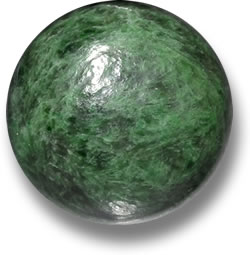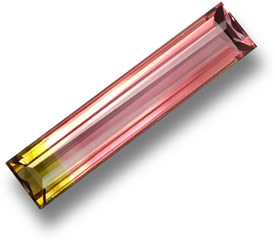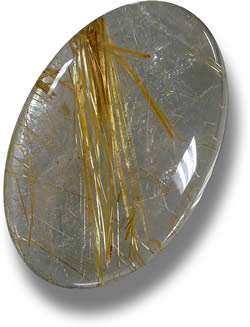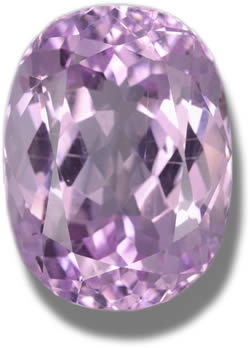|
Reviewed By Andreas Zabczyk
Untreated Gems for Jewelry - Part II
Untreated Maw-Sit-Sit from Burma
In continuation of our quest to become the most comprehensive online library of gemstone and jewelry information, we further expand on the subject of buying untreated gems for jewelry. In our first edition of Untreated Gemstones for Jewelry, we already a great number of popular colored stones that are completely natural and unenhanced, including aquamarine, cat's eye (chrysoberyl), moonstone and jade. We also brought forth some lesser-known untreated gemstone varieties, including alexandrite, labradorite, and goshenite, as well as some wonderful members of the garnet family of gems. When shopping for untreated gemstones, many believe that the selection is very limited, but this is certainly not the case. In fact, for those who know where to look, untreated gemstones can be found in just about every cut, shape, size and color imaginable. Best of all, many untreated gems are extremely affordable, including exotic gems like apple-green prehnite, royal blue lapis lazuli and phenomenal gems such as hawk's eye, pietersite or tiger's eye, all of which are highly prized for their incredible and attractive exhibition of simple chatoyancy, one of the many forms of optical phenomena found in colored stones. For those looking for something different, here are some more excellent options to consider when shopping for your next completely natural and untreated jewelry-gemstone: October BirthstonesOpal and tourmaline are both considered to be official birthstones for the month of October. They are ranked among the top gem choices for jewelry and both gemstone groups offer several unique untreated gem varieties. Opal is one of the most highly sought-after gemstones due to its remarkable ability to exhibit the optical phenomenon of opalescence and sometimes incredible 'play of color' too. There are three main opal categories; precious opal, common opal (also known as 'potch' or white opal) and fire opal, which was named after its vivid body color. There are many opal trade names used today, but most are unofficial varietal names that are used and referred to only by the most avid jewelry fanatics and mineral collectors. Most opal is untreated, but opal can be enhanced to increase durability (such as in doublets) or 'smoked' to darken its body color, which results in a stronger play of color. This older but modernized treatment is often used to enhance Ethiopian material. Smoked Ethiopian opal is often traded as enhanced Ethiopian 'black opal'. The chocolate opal from Ethiopia is also very dark in color, very similar to smoked 'black opal', but gems that are traded as 'chocolate opal' are usually untreated and completely natural in color. These beautiful opals often occur with excellent transparency and are known to exhibit very strong color play, which can include full spectrum color flashes of blue, green, red, pink, yellow, orange and purple. Some rare Ethiopian opals may even have turquoise or indigo flashes of color, which is almost unheard of, even with the finest Australian opal. 
Untreated Watermelon Tourmaline
Tourmaline, one of the largest gemstone families, is almost always untreated and happens to naturally occur in almost every color as well. Elongated crystals of tourmaline are often cut into long bars to maximize carat weight. Like other gems that form in many colors, tourmaline crystals can exhibit interesting color combinations. The popular color-zoned material known as watermelon tourmaline is often sold in gemstone slices and exhibits colors like the actual fruit. Sometimes it can be quite a challenge to find tourmaline that has been finished and worked into more traditional jewelry gemstone shapes and matching pairs and lots can be difficult to source. Tourmaline is a wonderful jewelry gemstone and overall, it is generally very affordable, though some rarer varieties can be very expensive, especially top grade gems found with excellent color, clarity and cut. The rarer forms of tourmaline include green chrome tourmaline, blue-green Paraiba tourmaline, blue indicolite and pink-red rubellite. Tourmaline is a favorite for jewelers because it offers excellent value and can be found in just about every color. Very large tourmaline gems are fairly easy to source, and because they're so readily available, tourmaline has become one of the most frequently worn gems for fashion jewelry, especially for oversized jewelry such as cocktail rings and large pins and pendants. Today, tourmaline is one of the best-known colored stones available today and is superior to many of the other materials available because it is almost never treated or enhanced in any way. 
Untreated Rutile Quartz Cabochon
Tourmaline gems also play an important role in the world of metaphysical and crystal healing. For those who believe in the energies and holistic powers that gemstones can possess, natural and untreated gemstones are preferred (which is one the many reasons why tourmaline is such an important gem). Since tourmaline is known to possess a pronounced piezoelectric effect, its therapeutic powers are believed to be much stronger than many other varieties of crystals. However, buyers should be aware that not all gemmy tourmaline is untreated. Beware of tourmaline that appears to be too vivid or neon-like, which is often an indication that it may have been heated. Gem analysis reports from reputable gemological labs can help alleviate concerns, but most colored stone reports only identify the gem type, so treatment verification should be specifically requested since it requires the use of advanced equipment. Quartz and SpinelThe very large and important family of quartz gemstones includes a wide variety of completely untreated varieties. It should be no surprise that it can be found in just about every color since it is one of Earth's most abundant materials, second only to feldspar. Of the many forms of quartz, only a handful of varieties are occasionally enhanced, such as dyed agate or heated and irradiated quartz. For the most part, the majority of quartz gemstones remain completely treatment-free all the way from production to retail. Some of the most popular untreated quartz gemstones include transparent quartz, such as colorless 'rock crystal' quartz and bi-colored ametrine, which has a unique combination of violet-purple amethyst and yellow-golden citrine in a single gemstone. With regard to translucent to opaque quartz, several untreated jewelry gems can be found, usually in the form of cabochons, including chalcedony, bloodstone, tiger's eye, hawk's eye, carnelian, agate and onyx. Perhaps best of all is that when it comes to hardness and durability, quartz sets the par as the benchmark material and for a natural gem that is completely untreated, most quartz remains modestly priced even in large sizes. Spinel is another important gemstone that is often used for jewelry. It is an ideal gem for those looking for durability combined with versatility. It is generally affordable, but unlike tourmaline or quartz, for example, spinel is not very well-known by most of the general public (even though it has been prized as a gemstone since times of antiquity). Spinel is one of the unsung wonders of the fascinating world of gems. Like diamond and a few other gemstone types, spinel is singly refractive, which can result in color that appears more pure than other gems with a similar color. Red spinel is most valuable and it is extremely rare, even rarer than ruby. Spinel is rarely found in large sizes, with faceted stones usually weighing no more than 1-2 carats. With excellent hardness and clarity, as well as exceptional fire and brilliance, fine spinel is one of the best value gems when it comes to untreated options. Many consider spinel to be one of the best investment gems, since fine spinel prices are rapidly increasing, month-after-month and year-after-year. 
Untreated Pink Spodumene - Kunzite
Spodumene, Topaz and MoreSpodumene may not have the most intriguing name, but the spodumene family includes a few gemstone varieties that have been rising in popularity for jewelry. The term 'spodumene' is usually only used to refer to the pale yellow variety and it occurs with excellent transparency. Green spodumene is a bit of a rarity and is traded as hiddenite. Green and yellow spodumene gems are not often worn as jewelry, mostly because both are not very well-known by most consumers. When spodumene occurs with a lovely light-violet to pink hue, it is traded as kunzite. Kunzite is the most popular variety of spodumene and was named after the former VP of Tiffany & Company, George Frederick Kunz (1856 - 1932). Kunz was a legendary gem and jewelry specialist who was personally responsible for introducing a number of colored stones to the American market. Kunzite is prized for its soft delicate color and like other forms of spodumene it is almost never treated or enhanced in any way. Some materials may be heated to improve color or clarity but it's usually brought from mine to market, completely unenhanced and treatment-free. When it comes to gemstones, topaz is perhaps one of the best-known varieties. Even those without any formal education in gems and jewelry have at least heard of the name. Although topaz is mostly known for its enhanced (irradiated) blue gemstone variety, topaz can indeed be found in a range of other, naturally occurring colors. These include the most precious and valuable topaz known as imperial topaz. Imperial topaz is yellow-golden to orange-red in color and although it can be enhanced through heating, the fiery color is usually completely natural. Natural pink topaz is also an untreated rarity. Colorless topaz and rutile topaz are both relatively inexpensive and are easily found in large sizes. Precious varieties of topaz, which include pink, yellow, golden, orange and red topaz, are all known to sell for very high premiums. White topaz is a good alternative to diamond and is available in various shapes and sizes. Like diamond, topaz is hard but it can also be fragile due to its cleavage. Zircon is also another great option for use as a diamond substitute, though most white zircon gems have been heated to improve clarity. Untreated colorless stones are widely available and almost all of them are available at more affordable prices than lab-grown diamond or synthetic substitutes, such as moissanite and even cubic zirconia. With so many natural choices, it is curious as to why anyone would want to buy synthetic materials when beautiful white topaz, quartz, beryl and sapphire are all easily found, all of which are completely natural and mined from the earth. Today, there are many specialty gem and jewelry stores that deal only in untreated gems. Most of these specialized suppliers are online dealers that boast a small handful of stock and usually carry no more than a few hundred sapphire or ruby pieces only. This could be why many people are unaware of the many other untreated gemstone options available today. At GemSelect, we have over 50 different untreated gemstone varieties available, with a total selection of more than 30,000 loose gemstones in stock. This means we carry more untreated colored gemstones than any other online gem and jewelry supplier that claims to specialize in untreated gems only. So, if you are looking for untreated colored gems, we're confident that you can find exactly what you need with us. If we don't have something you need, simply let us know and we'll be happy to help you in your search for something special. This Page in Other Languages
|
| STAY IN TOUCH | NEWSLETTER |
| *You're signing up to receive GemSelect promotional email. |
Copyright © 2005-2024 GemSelect.com all rights reserved.
Reproduction (text or graphics) without the express written consent of GemSelect.com (SETT Company Ltd.) is strictly prohibited.
2623